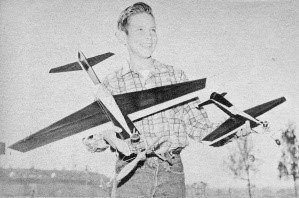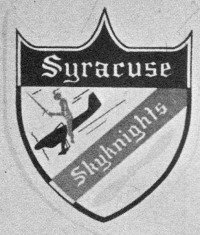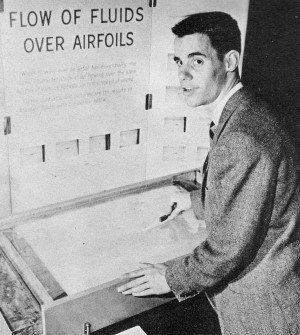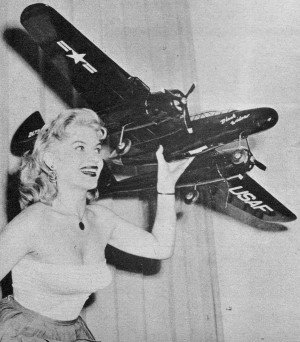|
It's the age-old problem of 20%
of the people doing 80% of the work, or maybe it's 10% of the people doing 90% of
work. In 1957 when this issue of American Modeler magazine was published,
clubs were suffering under the same lack of willingness on the part of its members
to do little (or no) more than pay annual dues and let someone else run the club
business, contests, and promotions. The author here makes a few suggestions for
how to get more people to participate in activities. A real sign of the times is
how one idea was to segment aeromodeling clubs into groups focusing on free flight,
control line, and the newfangled radio control. I guess there are very few "diverse"
clubs these days.
BTW, the article refers to the boy in the first photo as both Billy Swope and
Billy Snope. If you know which is correct, please let me know.
"Dope Can" by the Dopester
Maybe We Need "Do-it-Yourself" Model Contests!

Billy Swope has a hard time deciding whether the Half-A or double-size
"Hi Tailit" is his favorite model.
When the August issue arrived at the Snope doorstep last year in Torrance, Calif.,
subscriber John and son Billy spotted the "Hi Tailit" design submitted by University
of Arkansas students. This pert little Half-A control line job made such a hit with
the flyin' Snopes that they turned out two right away. Giving 'em contrasting paint
jobs and dubbing them "Negative" and "Positive" the father-and-son team found their
Hi-Tailits flew just fine.
In fact, John writes, "Billy became so enthused over the design, he asked me
to scale the plans up twice size. A "29" Torpedo was installed on the king size
copy, a little weight aft for balance, and it took to the air like it belonged there."
Lead photo shows Billy with his favorite model(s). Both he and his dad are members
of the LARKS (L.A. Radio Control Society) and the El Camino U-Controllers. John
is a photographer for the El Segundo division of Douglas Aircraft.
Helpful Herb. Busy model leader is the AMA's vice president
for District Four, Herbert J. Honecker. Photo shows him assisting Lt. Jack Munroe
of the Signal Corps when Munroe put on a flying demonstration before a group of
crafts directors and supervisors attending a Second U.S. Army conference.
These crafts directors were familiarized with all phases of model airplane flying
in preparation for the Army model meets which have become a permanent part of the
military program.

Army's Jack Munroe and AMA's Herb Honecker show craft directors
how to fly and judge control line models.
Honor Club. In the spotlight this month are the Syracuse, N.Y.,
Skyknights which started under the sponsorship of the Plymouth Aero League and the
Clell Forsythe Motors, local Plymouth dealer. Last count saw the club with 32 active
members who meet on alternate Friday evenings and fly every Sunday on a field near
Cicero donated by Mr. Forsythe. Main interest of members is radio control with some
activity in control line.
James R. Belknap, secretary, 507 Comstock Ave., submitted the emblem and the
data.
Subject All Wet. Chosen as one of the nation's most promising
young scientists, Dennis C. Ehn, 17, of Route 1, Ault, Colo., is shown with the
Westinghouse Science Talent Search project he devised for studying aerodynamics
using water instead of air since the cost of a wind tunnel is so high.
Dennis was one of 40 finalists, all high school seniors, invited to Washington,
D.C., and the 16th annual Science Talent Institute.
Horray For the Team(s).
America's Nordic A/2 Towline Glider Team Speed Team and F.A.I. Speed Team chosen
after local and regional qualifying rounds, and eligible to complete last August
in the finals in Czechoslovakia were as follows:
Nordic: Patrick Hoadley, 908 E. 3rd St., Bloomington, Ind.; Edward Christenson,
400 E. 23rd St., Lawrence, Kan.; Gerald Thomas, 503 E. Wright, Tacoma 4, Wash.;
and Jim Daley, 196 Harwood Ave., Littleton, Mass.
F.A.I. Speed: Bill Wisniewski 4261 Petaluma Ave., Long Beach, Cal; Arnold Nelson,
3803 Stevely Ave., Long Beach
8, Cal.; Fred Cook & Jim Clem (team) 3924 Hickory Tree Rd., Mesquite, Texas;
and Floyd S. Bradford, 4937 Verdura Ave., Lakewood 11, Cal.
Our congratulations to the qualifiers, and a pat on the back for the also-rans.
Too bad funds were not available to provide transportation for the teams; we wait
to hear if any made the trip on their own, or succeeded in having their models proxy-flown.
Peter J. Sotich, chairman of the 1957 International Competition Committee, and
his fellow working members deserve a real round of applause for all their hard work.
Also among those contributing to the program were the directors and clubs which
ran the qualifying rounds.
Congrats to "Cub." Herkimer Tool & Model Works of Herkimer,
N.Y., makers of the "OK" Cub power plants, fuels, plugs and associated items, celebrates
its 20th anniversary this year. Back in 1953 when the Herkimer folks were the subject
of a pictorial on engine-making in the Air Trail Model Annual they'd already lost
count of how many engines they had produced.
Heaven only knows what the total is by now; certainly the "OK" gang has lost
count. Here's wishing the entire crew, especially dad Charles Brebeck and son "Chuck"
Brebeck many more happy birthdays ... both business and personal.

Skynights of Syracuse, N. Y., wear this sweater emblem. Blue
shield, red name band, yellow prop.
Ray of Light. One guy who really gets around is Ray Bryan; he travels
the country representing various model manufacturers including the Veco folks. In
his work Ray calls upon a great number of hobby dealers during the year and gets
to see a lot of model activity including air-model meets.
The big problem of contest prizes has been bothering Ray for a long time. He
saw that Veco, like a lot of other model concerns, received hundreds of requests
each flying season for trophies, motors, cash donations, and so on. Which ones to
honor, which to pass by? Ah, there was the big question.
One day it dawned on Ray that the big thing lacking in aero-modeling (in most
sections) is the state championship meet. Under the sponsorship of the Exchange
Club in prewar days, many state champs were crowned and sent to the National meet.
But today fewer and fewer such trips are awarded.
Why not, mused R.B., give awards to meets which designate a state champion and
provide transportation costs to the National competition? The more he thought about
it and the more people he talked with, both in the model industry and in the activity
end of things, the more enthusiastic all became. That's one reason why this past
season has seen more state champs than in a long, long while.
As Ray points out, the "championship" angle can be split up very nicely among
various model clubs In a given state. One can run off control line stunt championships,
another the speed trials, another the R/C multi qualifications, and on and on. The
newspapers eat up a "championship" angle, too, almost always give feature attention
to anyone crowned as model champ. whereas winners with no titles receive scant attention.
Ray reports that investigations indicated modelers will turn out in just as large
numbers for a crack at a trip to the Nationals as for a big pile of standard trophy
and merchandise awards. Big thing to remember in all of this is to offer trips to
novice or junior flyers, as well as to the older age groups. You be surprised, says
Ray, how many winners will take bus-fare winnings, and add them to a car-pool fund
so more than just one or two can attend the Nats.
Here is something that all clubs should think over as a possibility for the next
contest season. Ray can be contacted through the Veco home office.

To eliminate wind tunnel cost, Dennis Ehn of Colorado studied
airfoils via less expensive water flow tank.
Do-It-Ourselves? Another thought that has been rattling around
the ole Dopester's brain-box this summer concerns the whys-and-wherefores of contests.
Perhaps many have been a disappointment to the sponsor, the organizer and the participants
because each expected a little too much.
Take a typical scene, repeated unfortunately in all too many places. The XYZ
Model Club wants to put on its annual meet. It goes to the local Whoop-de-do Service
Club, a big civic-boosting outfit whose members have hearts pure as gold and stand
ready always to lend a helping hand to any activity that will 1) publicize the community;
2) bring in visitors; 3) promote youthful participation in helpful hobbies or sports;
and maybe 4) bring in a few bucks to the Whoop-de-do treasury.
Nobody can quarrel with the motives of the Model Club or those of the service
club - especially #4 since Whoop-de-do funds go toward the support of the local
Orphans Home.
You know what sometimes happens. The service clubbers agree to purchase a certain
number of prizes, but want the model leaders to help round up merchandise awards
and trophies from the model manufacturers. Let's say the modelers are only partly
successful because the model industry folks have been solicited earlier by several
hundred other model groups and service-civic-military organizations also sponsoring
model meets.
Where to hold the meet? Well, it's to be a two-day affair. The free flight and
radio events will be at the local fair grounds (fair is long since past); control
line events will be at the high school stadium grounds. Terrible, yell the free
flighters; not enough flying area. Can't help it, say the sponsors, we gotta hold
it where we can attract a crowd so's we can sell enough food and soft drinks to
pay for the trophies, including the extra ones needed because you feel down on your
part of the bargain, or we'll lose our shirts and you'll never get another sponsor
in this town.
The control line crowd mutters that the stadium grounds are not right for a U-control
meet. Last time one was held there the spectators walked all over the models.
Sorry, fellows, we just have to run it where we can guarantee a good turn-out
of on-lookers. And so it goes. Oh, not always, but in all too many instances.
Comes the contest and if the crowd is small the sponsor is unhappy, the modelers
delighted. Of course, the free flighters don't all fly - "What, lose my model just
to, win an engine that costs less than the one I'm flying?"

Aristo-Craft's beautiful control line P-61 Black Widow model
delights lovely Eva Lynd (N. Y. Daily News Photo).
Control entrants come, many look, a few fly. And if the soft drink sale falls off,
listen to the howls.
Any solutions to, this problem? Well, first let us agree that this situation
does not exist everywhere. (In many localities the physical flying setup is good,
the working arrangements between model club and sponsor are better, and the "annuals"
a lot of fun with a lot of good prizes awarded.)
Okay - how do we run contests under conditions the modelers like? You gotta do-'em-yourself,
men! Here are a few suggestions ...
First, organize clubs into, divisions like control line, free flight, radio control.
Each group meets separately; a fellow can belong to more than one group providing
he is active in each category. If there are three different clubs in one locality,
band together in a sort of federation.
Each month each division runs a little contest for its own member enthusiasts.
By dividing into, teams, division meets can be conducted by different groups round-robin
style. The important thing here is that every flyer gets involved in the running
of a meet. This is the important part of Do-It-Yourself contesting! We've got to
stop relying on the other fellow to do all the work while we have all the fun if
we ever expect to have meets conducted the way we want them.
All right, you say, we now have each division broken up into teams which take
turns running separate monthly meets. What's next?
Next you are ready to, have the control liners and the free flighters band together
to run a meet for the R/C boys. Let's say this is in May sometime, In July the R/C
crowd and the free flight contingent get together and put on a shindig for the U-C
flyers. Then in September the free flighters have their day. To keep all fair and
square contest dates should be drawn out of a hat the first time, then rotated in
subsequent years.
We'll bet that a program organized like this would seen show that modelers can
be made to work and with a willingness that would astonish many an old-time contest
director.
By a club running its own meet, it can then select a site to suit the flyer instead
of the spectator. A site most suitable for the model is almost always a safer spot
for the onlooker, too. Contests should be built up as family affairs; get the flyers
and the workers to bring along the entire household. It makes a big difference in
the complexion of meets. The greater the family's participation, the mere fun for
all.
Does it all sound too easy? We don't mean it that way. But the sooner model clubs
start relying on their own initiative and less on the sponsor's, the faster we'll
see some real "for-modeler" meets springing up around the country.
And you knew what? It's a lot easier to attract a sponsor to a meet on your terms
if it's a successful, goin' affair!
Airplane Bulletin. Here's .the latest model airplane bulletin.
We issue them monthly," says B. B. Winston of America's Hobby Center. "Just a hodge
podge of new items, good buys and miscellaneous offerings." What a collection! New
Pactra fuel, Hawk zeppelin kit, full line of Fox engines illustrated, new Monitor
and Merrimac, plus hundreds of hard-to-get items like checkerboard silk, Sea Scooter
kit, reed tachometer, miniature machine guns, and on and on. AHC, 146 W. 22nd St.,
NYC 11.
Importance of Modeling. Hewitt Phillips, one-time model champ
of Boston's Junior Aviation League, new big wheel with the National Advisory Committee
for Aeronautics, sends along a publication by North American Aviation. Therein we
find a highly technical report on the "heat" barrier by Maury Sulkin, chief thermodynamicist
of NAA's Los Angeles division. Hew knew Maury as a J.A.L. model flyer.
Also, a model "graduate" from the same League is Robert Wykes, another NAA engineer
on the West Coast. Bob's brother John flew models, now plans the real ones for NAA.
Someday, some how, the full scale aviation and engine industry will awake to
the fact that modeling is its greater provider of new talent. Let's hope the realization
comes soon.
Contest Calendar. Each issue we list all corning competitions.
Notice of these should be sent to, American Modeler at least 90 days in advance.
List also, special hobby shows, model exhibitions, R/C get-togethers, technical
sessions, "open house" gatherings, and other events of direct interest to readers.
Send listings to, "Contest Calendar," care of this magazine. (This publication
assumes no, responsibility for errors in listings.)
Posted June 11, 2022
(updated from original post
on 4/8/2012)
|